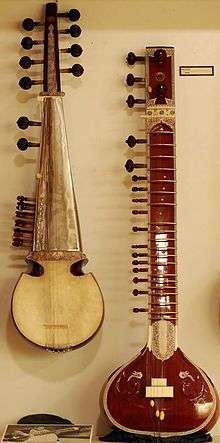Gamak (music)
Gamaka, also known as gamak, refer to ornamentation that is used in the performance of North and South Indian classical music.[1] Gamaka can be understood as embellishment done on a note or between two notes. Present-day Carnatic music uses at least fifteen different kinds of ornamentation. [2] Gamaka is any graceful turn, curve or cornering touch given to a single note or a group of notes, which adds emphasis to each raga's individuality.[3] Gamaka can be understood as any movement done on a note or in between two notes. The unique character of each raga is given by its gamakas, making their role essential rather than decorative in Indian music.[4] Nearly all Indian musical treatises have a section dedicated to describing, listing and characterising gamakas.[5]
The term gamaka itself means "ornamented note" in Sanskrit.[5] Gamakas involve the variation of pitch of a note, using heavy forceful oscillations between adjacent and distant notes.[6] Each raga has specific rules on the types of gamakas that might be applied to specific notes, and the types that may not.
Various commentators on Indian music have mentioned different numbers of gamakas. For example, Sarangadeva describes fifteen gamakas, Narada in Sangeeta Makaranda describes nineteen gamakas, and Haripala in Sangeet Sudhakar describes seven gamakas.[7]
Types of gamakas in Indian music
- Tiripa
- Sphurita
- Kampita
- Leena
- Andolita
- Vali
- Tribhinna
- Kurula
- Aahata
- Ulhasita
- Humphita
- Mudrita
- Namita
- Plavita
- Mishrita
Carnatic music gamakas
Carnatic music has several ornamentation classes, which can be divided into major groups as shown in the table below. These and many more gamakas are mentioned in various treatises and compositions including Arohana (ascending patterns), Avarohana (descending patterns), ahata & pratyahata.[8]
Carnatic ragas can fall under several categories based on their tolerance and dependence on gamakas. For instance, those like Nayaki, Sahana, Devagandhari, Yadukulakambhodhi etc can never exist without key gamakas like kampita whereas ragas like Keeravani & Shanmukhapriya can sound acceptable with full or partial oscillations. Ragas like Hindola and Revati can be rendered with minimal oscillations.
| Carnatic Ornamentation Category | Western music Equivalent | Subtypes |
|---|---|---|
| Kampita | Deflections/oscillations | Kampita – Probably the defining gamaka in Carnatic, kampita is oscillation of notes. Most of these oscillations are very unique to Carnatic and distinctive from other shakes seen in world music. Kampita can be of various types based on speed, amplitude and/or and number of repeats the note is oscillated, based on musical context within a raga. For instance, the Ma in Shankarabharana/Begada can itself be oscillated in various ways based on the type of phrase rendered and its preceding/succeeding notes or phrase.
Nokku – stress from above on successive (non-repeated) tones, Odukkal – stress from below on successive (non-repeated) tones, Orikai – momentary flick, at the end of the main tone, to a higher tone |
| Janta | Fingered/vocalised Stresses |
Sphurita – A note repeated twice with upward force from the note immediately below on 2nd time (SS-RR-GG-MM etc), Ahata - 2 note phrases in ascending order where the first note is given an upward force from the note immediately below (SR-RG-GM-MP-PD etc) Pratyahata – 2 note phrases in descending order where the first note is given an upward force from the note immediately below (SN-ND-DP-PM-MG etc) , Khandippu – sharp dynamic accent, Tripuchcha - A note repeated 3 times with upward force from the note immediately below on 2nd & 3rd times (SSS-RRR-GGG-MMM etc) |
| Andola | Swings | Movements of various notes in a swinging fashion (SRSG,G - SRSM,M - SRSP,P) etc |
| Daalu/Daatu | Skips | Daalu - Jumping to various notes from the same note - SG - SM - SP - SD or GD - GN - GS etc.
Daatu - Skipping notes from any note - RM, DS, PR, NPRM, SGPS etc |
| Jaaru/Ullasita | Glides/glissandos | Irakka-jaru – descending slide, Etra-jaru – ascending slide |
| Tribhinna | Polyphony | Striking 3 notes at the same time (usually on instruments) |
Hindustani music gamakas
Hindustani music has five gamakas. The gamaka is similar to meend and andolan.
Gamakas in music notation
Notation of gamakas is generally not found in the Indian music system. There can be considerable difficulty in conveying the complex and fluid melodic movement of gamakas in a notation system that uses fixed pitch signs.[9] In Carnatic music in particular, the notation of gamakas is often unnecessary, as performers use notation as a memory aid for compositions they already learned by hearing and imitating.[9]
However, there are some old scripts and books like the Sangeetha Sampradaya Pradarshini, which have specific signs to indicate the gamakas that have to be used for each note. Usage of such symbols makes it easier to understand the notation and to sing the composition.
Notes
- Kassebaum (2000), p93
- Appreciating Carnatic Music by Chitravina N Ravikiran, Pub: Ganesh & Co
- Prof. P Sambamoorthy (2005), South Indian Music – Vol I, Chennai, India: The Indian Music Publishing House, p. 18
- Viswanathan, T (1977). "The Analysis of Rāga Ālāpana in South Indian Music". Asian Music. 9 (1): 13–71. doi:10.2307/833817.
- Powers, Harry S. (1958). "Mode and Raga". The Musical Quarterly. 44 (4): 448–460. doi:10.1093/mq/xliv.4.448.
- Introduction to Gamak at the ITC Sangeet Research Academy
- Menon, Raghava R. (1995). The Penguin Dictionary of Indian Classical Music. Penguin Books (India) Ltd. p. 61. ISBN 0-14-051324-8.
- Balasarasa murali - Keeravani krti of Oottukkadu Venkata Kavi
- Swift, Gordon (1990). "South Indian "Gamak" and the Violin". Asian Music. 21 (2): 71–89. doi:10.2307/834112.
